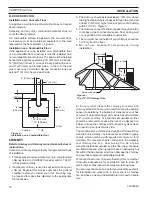
VSW40 Wood Stove
12
20300060
OPERATION & MAINTENANCE
BUILdING A FIRE
1. Open inlet air control fully.
2. Place a small amount of crumpled paper in the
stove.
3. Cover the paper with a generous amount of kindling
wood in a teepee fashion and a few small pieces of
wood.
4. Ignite the paper and close door. If fire dies down
substantially, open door slightly.
5. Add larger pieces of wood as the fire progresses being
careful not to overload. Do not fill firebox beyond
firebrick area. An ideal coal bed of 1" (25 mm) to 2"
(51 mm) should be established to achieve optimum
performance.
6. This unit is designed to function most effectively when
air is allowed to circulate to all areas of the firebox. An
ideal means of achieving this is to rake a slight (1" to
2" wide) trough in the center of the coal bed from front
to back prior to loading the fuel.
7. Once fuel has been loaded, close door and open air
inlet control fully until fire is well established (approx.
10 minutes) being careful not to over fire.
8. Re-adjust air inlet control to desired burn rate. If
excessive smoke fills firebox, open air inlet control
slightly until flames resume and wood is sufficiently
ignited. A basic rule of thumb is “closed – low,” "1/2
way-medium,” and “fully open – high.”
9. When refueling, adjust air control to the fully open
position. When fire brightens, slowly and carefully
open the door. This procedure will prevent gases from
igniting causing smoke and flame spillage.
10. Add fuel being careful not to overload.
A
ST1013
air control
10/08
Low Burn
High Burn
Figure 6 -
Air Control Layout
ST1013
MAINTENANCE
REMOVING FIREBRICk
To r e m o v e
firebrick, lift up
from bottom
a n d r o t a t e
o u t w a r d .
Figure 7
ST1018
remove firebrick
Firebrick
ST1018
Figure 7 -
Removing Firebrick
GLASS CARE
REPLACE GLASS ONLY WITh hIGh TEMPERATURE
CERAMIC AVAILABLE FROM YOUR LOCAL Vermont
Castings dEALER
The following use and safety tips should be observed:
1. Inspect the glass regularly for cracks and breaks. If you
detect a crack or break, extinguish the fire immediately,
and contact your dealer for replacement.
2. Do not slam door or otherwise impact the glass. When
closing doors, make sure that logs or other objects do
not protrude to impact the glass.
3. Do not clean the glass with materials which may scratch
(or otherwise damage) the glass. Scratches on the
glass can develop into cracks or breaks.
4. Never attempt to clean the glass while unit is hot. Light
deposits are normal. Heavier deposits may be removed
with the use of a readily available oven cleaner.
5. Never put substances which can ignite explosively in
the unit since even small explosions in confined areas
can blow out the glass.
6. This unit has an air wash system designed to reduce
deposits on glass.
GASkET REPLACEMENT
After extensive use, the sealing material which provides
glass and door seal may need to be replaced if it fails
to sustain its resilience. Inspect glass and door seal
periodically to ensure proper seal: if gaskets become
frayed or worn, replace immediately. Contact your Vermont
Castings dealer for approved replacement parts. Refer to
replacement parts list in this manual.
The following steps should be followed for glass gasket
replacement:






































